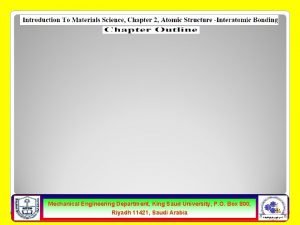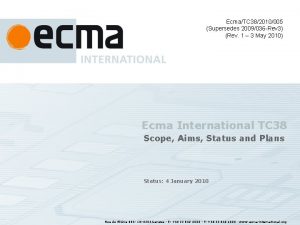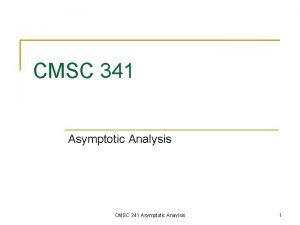King Saud University College of Engineering IE 341
















- Slides: 16

King Saud University College of Engineering IE – 341: “Human Factors Engineering” Spring – 2016 (2 nd Sem. 1436 -7 H) Chapter 10. Human Control of Systems (Compatibility) – Part I Prepared by: Ahmed M. El-Sherbeeny, Ph. D 1

Contents • Introduction • Spatial Compatibility o Applications • Movement Compatibility o Applications • Modal Compatibility (from ch. 3) o Application 2

Introduction • Human function in system control: o Receive information o Select action mode o Execute action • Human action: o o Becomes control input to the system Remember (Ch. 1) output of 1 system input to another system Output of system: usually as feedback regarding effects of action Then human function starts again (as listed above, and so forth) • Human functions involved with system control: o Compatibility (discussed here; most important), also: o Tracking (not discussed here) o Supervisor control (not discussed here) 3

Cont. Introduction • Compatibility: o Considers relation between controls and displays o Determines how easy and convenient people choose and perform correct actions given several alternatives • Definition: o “degree to which relationships are consistent with human expectations” • Types of compatibility o Conceptual, Spatial, Movement, and Modality (discussed in ch. 3) o Discuss here: spatial and movement i. t. o. relation between control & display • Effect of compatibility: o o Faster learning Faster reaction/response time (RT) Less errors Higher user satisfaction 4

Cont. Introduction • Effect of non-compatibility: o People can get used to non-compatible (“out of sync”) systems, but: o There’s higher information processing burden on user (i. e. more thinking) o Under stress conditions: user may make compatible (i. e. natural response) which (here) will be incorrect response error or accident • Special considerations for compatibility relationships o Some are stronger than others • E. g. when shared by a larger group of population than others o Sometimes it is necessary to violate a compatibility relationship to make use of another one • E. g. study by Bergum (1981) for subject group 93% expected upward movement of pointer increase 71% (of same group) expected numbers to increase: top to bottom! 5

Spatial Compatibility 6

Spatial Compatibility • Types of spatial compatibility A. Physical similarities of displays and controls B. Physical arrangement of displays and controls A. Physical similarities of displays and controls o Involves design of displays/controls in order to have similar: • Physical features • Modes of operation • Case 1: study by Fitts and Seeger (1953) o Three displays / three controls (all combinations used) (see next slide) o Displays: lights in various arrangements o With light operation subject moves stylus along corresponding channel to turn light off o Each group of subjects attempted each of 9 possible combinations o Performance measured as: RT, errors, information lost (bits) o Results: • Best performance: when stimulus panel resembled response panel 7 • Best combinations (Sa-Ra, Sb-Rb , Sc-Rc)

Cont. Spatial Compatibility Cont. A. Physical similarities of displays and controls 8

Cont. Spatial Compatibility Cont. A. Physical similarities of displays and controls • Case 2: keyboard and screen (Bayerl, et al, 1988) o Keys on keyboard arranged as: • Rows on top or • Columns on one side (see next slide) o Meaning of keys depends on software (as screen label for each key) o Authors compared different screen vs. keyboard layouts, i. t. o: • Mean time to find and press keys (i. e. RT) o Result: • RT is smaller (i. e. higher compatibility) when labels (on screen) and keyboard configurations are physically similar 9

Cont. Spatial Compatibility Cont. A. Physical similarities of displays and controls 10

Cont. Spatial Compatibility B. Physical arrangement of displays and controls o This involves applications of findings of first two experiments o Most famous: burner control arrangement on 4 -burner stove • Control-Burner arrangement experiments o Several studies conducted (Chapanis, 1959; Ray, 1979) (see next slide) o Subjects: • Presented with various arrangements of controls / burners • Asked to turn on specific burners o Number of errors recorded o Results: • Two studies similarly ranked various arrangements • Exercise: rank arrangements on following slide from best to worst 11

Cont. Spatial Compatibility Cont. B. Physical arrangement of displays and controls 12

Cont. Spatial Compatibility Cont. B. Physical arrangement of displays and controls • Control-Burner arrangement experiments o Another experiment (Shinar, 1978): o Subjects asked to indicate burners for unmarked controls • 31% chose arrangement III • 25% chose arrangement II (yet with less errors than III) o Conclusions: • People don’t always choose options resulting in optimum performance • Better to use performance measures (vs. subjective measures) to decide on best display/control arrangements 13

Cont. Spatial Compatibility Cont. B. Physical arrangement of displays and controls • Control-Burner arrangement experiments o Another experiment (Osborne, 1987): o Added “sensor lines” to stove top (see next slide): • Lines are drawn from controls to corresponding displays • Senor lines: either partial or complete set • They used arrangement II (from first experiments) o Offset arrangement (from first experiments) also added for comparison o Which do you think gave: least RT, least errors? o Results: sensor lines greatly reduced RT, almost eliminated errors Arrangement Response Time Errors Offset (I) 0 Aligned (II) – complete sensor lines 0 Aligned (II) – partial sensor lines 0 Aligned (II) – no sensor lines Most time* 14

Cont. Spatial Compatibility Cont. B. Physical arrangement of displays and controls 15

Cont. Spatial Compatibility Cont. B. Physical arrangement of displays and controls • Control-Burner arrangement experiments o Watch example in You. Tube video: “Ergonomics and Design” (from start until 4: 06) https: //youtu. be/LAKlmd. MHpd. E? list=PLV-xl. Apuz 3 Hb. J 66 G 4 pqxzd. YO 7 o_3 x. ZEi 1 Note the Stove example 16
 King saud university college of medicine
King saud university college of medicine King saud university college of medicine
King saud university college of medicine King saud university college of medicine
King saud university college of medicine King saud university college of pharmacy
King saud university college of pharmacy King saud university college of medicine
King saud university college of medicine King saud university college of pharmacy
King saud university college of pharmacy King saud university college of pharmacy
King saud university college of pharmacy King saud university college of business administration
King saud university college of business administration King saud university mechanical engineering
King saud university mechanical engineering King saud university riyadh
King saud university riyadh King saud university hospital nurse salary
King saud university hospital nurse salary College of engineering, king abdulaziz university
College of engineering, king abdulaziz university Oscillopsia
Oscillopsia 沈榮麟
沈榮麟 Sda hymn 341
Sda hymn 341 Ecma-341
Ecma-341 Cmsc 341
Cmsc 341































